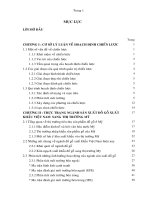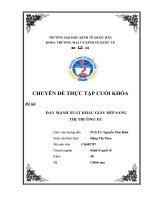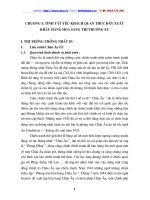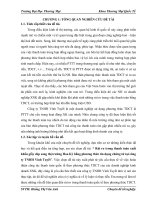Phương án xuất khẩu xi măng sang thị trường myanmare
Bạn đang xem bản rút gọn của tài liệu. Xem và tải ngay bản đầy đủ của tài liệu tại đây (141.46 KB, 9 trang )
PHƯƠNG ÁN XUẤT KHẨU XI MĂNG SANG THỊ TRƯỜNG MYANMAR
Republic of the Union of Myanmar also known as Burma is a country in
Southeast Asia, northwest of the Sino-Indian peninsula. Myanmar is a country which
is rich in mineral resources and reserves of natural gas in the world's 13-14 position,
fertile land with a total cultivated area of 23 million hectares, accounting for 40% of
the total value of agricultural production export. Potential, investment opportunities in
Myanmar are great, not only attractive in investment, Myanmar also has quite
important geo-political location, so some big countries such as China, India, U.S., and
Japan are very interested. I feel Myanmar is a country which has the long-term
and wise investment potential for the expansion of our business producing
construction
materials,
with
the
following
reasons:
Natural conditions of Myanmar: Republic of the Union of Myanmar is a
country in Southeast Asia, northwest of the Sino-Indian peninsula. There are 5,876 km
border with China (2,185 km), Thailand (1,800 km), India (1,463 km), Laos (235 km)
and Bangladesh (193 km). Its coastline is 1,930 km. Its area is 676,577 km ², it is the
largest country in mainland Southeast Asia, and is the 40th largest country in the
world (after Zambia). In 2011, arable land accounts for 15.3% (2% in water), 0.5% of
pasture, forest and shrubs of 49.3%, other land of 34.9%. Main minerals: petroleum,
tin, zinc, antimony, copper, tungsten, lead, coal, precious stones.
Administration: Myanmar is divided into seven states and seven administrative
regions. The largest area is Bamar; other states are essentially the habitable zone of
some particular ethnic groups. The administrative area is further divided into cities,
regions and villages. The largest city is divided into districts. The areas and states of
Myanmar are divided into districts (kayaing). Shan state is the state with the most
districts (11 districts). The Chin State, Mon State and Kayah State has only two
districts in each state. Capital: Naypyidaw (new capital), Rangoon (old capital)
Relationships between Vietnam and Myanmar: Myanmar set ambassadoriallevel diplomatic relations with Vietnam from May 25, 1975. Myanmar is one of the
few countries that Vietnam set relations very soon. Only two years after Vietnam
gained its independence, in 1947, the Democratic Republic of Vietnam has opened its
representative office in the Rangoon capital (now called Nay Pyi). At that time,
representative Office was assigned to more important tasks, including special task of
buying weapons and transport weapons and ammunition in the country to serve the
war against the French colonialists.
November 1954, Prime Minister U Nu official visited to the Democratic
Republic of Vietnam and December 1958, President Ho Chi Minh paid an official visit
to Burma. December 1957, the two countries established the Consulate General and in
May 1975 establishing diplomatic relations of Ambassador Level, Consulate General
Agency became the country's first embassy in Vietnam Democratic Republic in
Burma. Since then, relations of friendship and cooperation between the two countries
are constantly evolving for the benefit of the people of Vietnam and Myanmar, for
peace, stability and cooperation in Southeast Asia.
Politics: On October 22, 2010, Myanmar claimed to change its official name to
Republic of the Union of Myanmar, changing its national flag and national anthem.
The event took place just before the 17 days of the election after 20 years since the
latest election happened before in 1990. Residential racial diversity in Myanmar plays
an important role in determining the political and demographic history of the modern
nation. The country's political system remains under the tight control of the State
Peace and Development Council, military government led by Senior General Than
Shwe since 1992. As a former colony within the British Empire until 1948, Myanmar
continued to struggle to improve the ethnic tensions, and overcame the coups. Its
culture is heavily influenced from the surrounding countries, based on a unique
Buddhism form that merges local factors.
Economy
- GDP: $ 82,68 billion (2011)*
- GDP per capita: $ 1,300 (2011)*
- Growth: 5,5% (2011)*
Source: CIA Facbook Myanma 2012
In the British colonial period, Burma was one of the richest countries in
Southeast Asia. This was the largest rice exporter in the world and was the oil supplier
through the Burma Oil and Gas Company. Burma also had rich natural resources and
abundant human resources. They produced 75% of the world's teak, and the
population had a high literacy rate. This country ever trusted to have rapid
development future.
Myanmar is a country which is rich in natural resources, fertile land with a total
cultivated area of 23 million hectares. Agriculture accounts for 40% of total export
value. Since 1988, Myanmar has reformed the economy from administrative subsidies
to a market economy, issuing foreign investment legislation, allowing the
establishment of private enterprises. GDP growth between 1989 and 1996 respectively
improved. In five years (1996-2001), Myanmar GDP growth average was 5.5% /year.
Government introduced the 10-year economic development plan from 2001 to 2011
with an average GDP growth of 7.2% / year. Economic growth was 4% in 2004-2005,
about 5.5% in the period 2009 - 2011. Foreign investment had 374 projects from 25
countries and territories, including investment from ASEAN countries were $3.844
billion accounting for 51.64%. Total trade turnover between Myanmar and other
countries in 2005-2006 was $ 5.5 billion; however, it has jumped in the period of
2011, reaching $15.041 billion.
Economic Environment: In economy, Myanmar is a country with rich natural
resources, can be seen as the last golden land that has not been exploited in Asia. After
successful transfer to the civil authorities, foreign direct investment promises to
increase strongly, rapid economic growth potential, as witnessed in Vietnam in the
1990s.
Legal: The legal system of Myanmar under the British - American legal system
(Common law), the legal system is to be completed, in 2012 it has promulgated the
Law on Foreign Investment.
Basically, this law has many changes to be more favorable for foreign investors
(investors). For example, the lease period up to 70 years instead of 45 years in the old
law. Corporate income tax incentives are also longer. If before, investors were exempt
3 years from the first year of production, now the exemption is 5 years. Then, if
deemed beneficial to Myanmar, the government may decide to extend the time limit
for tax exemption.
In addition, Myanmar is also encouraging investment in areas to create more
jobs, environmentally friendly, promoting technology transfer and production
replacing import goods. Another change is that if the previous investors must
contribute at least 35% in the joint venture, now this ratio of capital contribution will
be agreed by the partners.
Licensed investment review period is shortened. Under the new law, the Myanmar
Investment Commission (MIC) will look to answer the investors that the project has
been approved or not within 15 days after receiving a complete dossier, and if
approved, within 90 days license will be issued. This term may be extended up to 6
months or 1 year before.
Myanmar is the only country to grant visa at the right border for citizens from
countries to Myanmar. Specifically, tourists are allowed to stay 28 days (no
extension), business stays of 70 days (extended), public affairs are 28 days (extended).
Especially, in addition to 4 domestic airports, two international flights from Vietnam,
Bangkok, Myanmar will have more direct flights from Malaysia to Yangon in August.
98% * (Source: Vietstock)
* Some documents signed with Vietnam
- Agreement on establishment of the Joint Commission on bilateral cooperation
between the two countries (5/1994);
- Trade Agreement (5/1994);
- Agreement on Tourism Cooperation (5/1994);
- MOU on 6-year-Cooperation Programme (1994-2000) between the two Ministries of
Agriculture (8/1994);
- MOU on Drugs Cooperation (3/1995);
- MOU on Cooperation in the field of Forestry (3/1995);
- Agreements to avoid double taxation (5/2000);
- Agreement on Promotion and Protection of Investment (5/2000);
- Cultural Cooperation Agreement (5/2000);
- MOU on Cooperation between CEMA and mountainous of Vietnam and the Borders,
Ethnicity and Development of Myanmar (7/2000);
- Memorandum of Understanding to establish a Committee on Trade (5/2002);
- MOU on Cooperation between the Chamber of Commerce and Industry (5/2002);
- MOU on investment promotion by the Ministry of Planning and Investment of
Vietnam and the Ministry of Myanmar Economic Planning and Development signed
(4/2010) * Source: The Foreign Investment Department - The Ministry of Planning
and Investment of Vietnam
Social conditions:
-
Population: 54.584.650 people (July 2012) *
-
The population compared to other countries in the world ranked 24
-
Rate of population increase is 1.07%, ranking 108 compared with countries
in the world
-
Age 15 to 64 accounted for 69.3% *
-
Ethnicity: Buddhist 89%, Christian 4% (Baptist 3%, Roman Catholic 1%),
Muslim 4%, animist 1%, other 2%*
* Source CIA Facbook Myanma 2012
- Burmese, the mother tongue of the Bamar and official language of Burma,
related to Tibetan and Chinese linguistically. Traditional Myanmar society is
emphasizing the importance of education. Inside the village, education taught by the
missionaries usually takes place in the temple. Secondary education and college /
university education are in the government schools. Buddhism is considered as the
state religion accounted for 89.3% of the population, Christians of 4.9%, Muslims of
3.8%. English is used extensively in agencies, offices.
* Business sector we choose to invest in Myanmar is the production of
construction materials: cement namely
According to the Foreign Investment Law of Myanmar and some bilateral
documents signed between Vietnam and Myanmar, it is highly recommended
investment from a number of areas such as:
- Equipment and telecommunications services; agricultural production; processing of
agricultural products, cultivation; exploration and exploitation of minerals
- Production of construction materials such as cement, bathroom equipment and
brick...
"In the future, the demand for construction materials in Myanmar for infrastructure,
construction of facilities is huge. According to survey of Myanmar Company, demand
for cement in Myanmar is about 5.35 million tonnes per years. Homeland only meets
65%, the rest are imported from Thailand and China. Regarding steel, each year this
country needs about 500,000 tonnes, but domestic production meets only 1%.
Similarly, brick manufacturing capabilities in this country can only meet 70% of
demand,
the
rest
are
imported.
(Source:
/>
doanh/2012/09/ton-kho-vat-lieu-xay-dung-hang-nghin-ty-dong/)
- Cement production is an area of heavy industry required a lot of labor and
mostly unskilled workers, while the labor of Myanmar is abundant with population of
over 50 million people, cheap worker and income per capita of $1,300 / year, while in
Vietnam it is $3,400 / year, the Myanmar people are gentle, hard, Buddhism is
considered the state religion accounted for 69.3% of the population
- Myanmar is a country with a lot of area of hills, it's easy to exploit and produce
Portland cement because of available limestones.
* Before entering the international business projects it is often very convenient,
but sometimes these risks are also needed researching specifically:
- First is the knowledge and understanding of foreign investment: the ability to
communicate in English, culture and ways of working of Myanmar, in-depth
understanding of the ways, the general sequence of foreign investment (must apply for
permission to invest in Vietnam, way to establish project feasibility reports, etc.).
Then do market research carefully in the field of investments, based on that, giving
appropriate investment strategy: to send qualified personnel to research the market,
the legal framework and law related to the field of market conditions, trend
assessment, potential, gathering data, making feasibility study report in detail. If
necessary, hire an attorney or local consulting firm to learn relevant laws.
- The company must prepare adequate human resources (staffs have
determination, professional qualifications, management experience, willing to stick to
the area), sufficient financial capacity (equity and fixed loans if needed), and have
enough experience, the level of technology in the field of expected investment. It is
necessary to find and choose the right partner (in terms of reliability, financial
capability, experience, etc.).
* Reference sources:
- Foreign Investment Agency - Ministry of Planning and Investment of
Vietnam
- CIA Facbook Myanma 2012
- VietStock
- />- />- />- />- />







